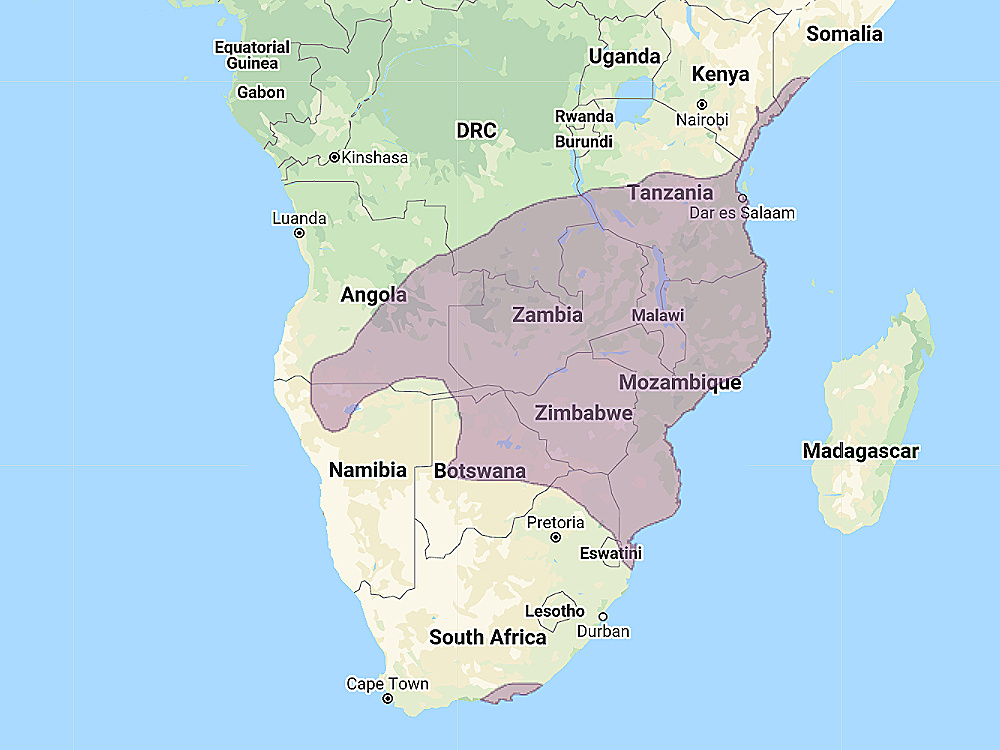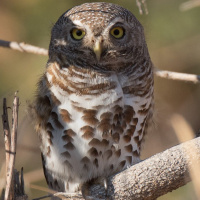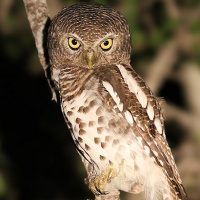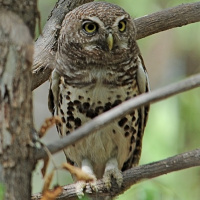Introduction
The African Barred Owlet is a small owl with a rounded head and no ear tufts.
Photo Gallery (5 pictures)
Sound Gallery
Information
Description: The facial disc is pale brownish with white concentric lines. The eyebrows are whitish. The eyes are yellow, and the cere and
bill are pale greenish-grey with a yellowish tint. The head and nape are greyish-brown to dark earth-brown and densely marked with fine whitish bars. The
mantle, back and uppertail-coverts are dark cinnamon-brown, narrowly barred buff. The scapulars are cinnamon-brown with large whitish areas on the outer webs
and dark brown tips, forming a distinct whitish row across the shoulder. Flight feathers are barred cinnamon-brown and rufous-brown. The tail is greyish-brown,
and densely barred with pale buff.
The throat and upper breast is greyish-brown, densely barred buffish-white. The rest of the underparts are off-white, with a pale buffish wash, and with large,
dark brown dots at the tips of several feathers. Underwing-coverts are whitish-buff with some brown spots.
Tarsi are feathered whitish with a rufous wash. Toes are brownish-yellow to yellowish-olive, and bristled. Claws are horn with darker tips.
Size: Length 20-22cm. Wing length 131-150mm. Tail length 74-101mm. Weight 81-139g. Females are heavier than males.
Habits: The African Barred Owlet is a partly diurnal bird. Main vocal activity is at dusk and dawn, but they are also active on calm, clear nights. Normally roosts within cover, sometimes in a natural hole in a tree. Flight is low with whirring wingbeats, swooping up to perch. This owl appears to bathe frequently.
Voice: The song of the male is a series of about 6-8 equally spaced, whistled, slightly downward-inflected notes at about one per second - "kweeu-kweeu-kweeu-kweeu-kweeu-kweeu". This phrase is repeated after about 15-20 seconds. The female gives a similar but slightly higher pitched song. When excited, both sexes utter a series of short purring notes than sometimes accelerate and run together. Croaking notes are uttered if disturbed at roost. At the nest, the male and female give soft "twoo" calls.
Hunting & Food: Feeds on small mammals and birds, reptiles, frogs, insects and other arthropods including scorpions and caterpillars. Prey is normally caught from a perch.
Breeding: Male and female owls sing together to claim territory. Egg laying normally takes place in September and November. The nest is a natural cavity or tree hole made by a woodpecker or barbet. These may be about 3-6 metres above the ground and about 15-30cm deep. The female lays 2-3 white eggs (average 32.1 x 27.1mm) at two day intervals directly on the floor of the cavity. The incubation period is not known. After hatching, the young are fed by both parents, always after dusk and not during the day. Nestlings leave the nest at 30-33 days old, and are cared for by both parents for some time. At seven months, they may sing like adults, and sexual maturity is reached in the next breeding season.
Habitat: Open areas with riverine forest, woods with large trees, forest edge and secondary growth. This owl is usually found below 1200m elevation.
Distribution: Eastern coast of southern Somalia, Kenya and northeast Tanzania. From there west through southern Democratic Republic of the Congo, Zambia and Angola to northern Namibia and south through Malawi, Mozambique, Zimbabwe and Botswana to northern South Africa. Also present in the Southeast corner of South Africa.

Range of the African Barred Owlet Glaucidium capense
Status: Listed as 'Least Concern' by Birdlife International.
Original Description: Smith, Sir (Dr.) Andrew. 1834. South African Quarterly Journal (S. Afr. Q. J) (2): p. 313.







